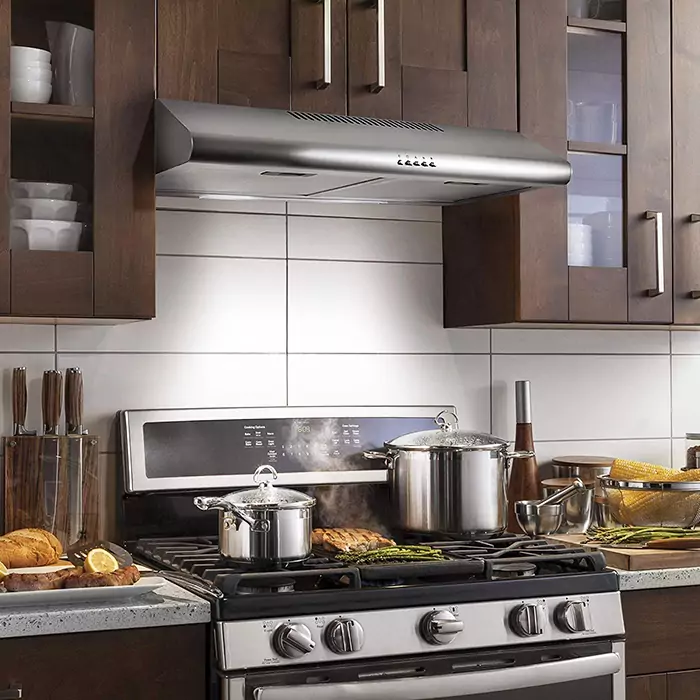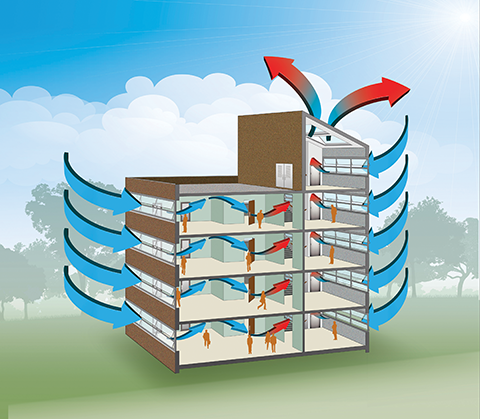In any cleanest apartment, in which the owner regularly cleans and continuously erases dust and stains from everywhere, there is a place where fumes, soot, harmful fumes, and even poisonous gases are produced. This place is called the kitchen. Tasty and healthy food is prepared in the kitchen, but secondary by-products include odors from heat treatment of food products, splashes from boiling pots and pans, and smoke from unburned fuel.
Types Of Ventilation
In houses of different designs and different purposes, ventilation systems are built differently. The design of the system depends on the number of storeys of the house, the material of the walls, and the design of the windows.
Depending on the initialization of the gas flow in the room, ventilation can be natural or forced. In the first case, the airflow moves indoors due to the difference in temperatures inside and outside the house. Warm air rises and exits through the ventilation duct of the system to the outside, and the freed volume is filled with fresh, colder air from the street. If in the recent past, the influx came through cracks in windows and doors, now, with higher quality construction, it is necessary to specially equip devices to allow outside air into the room. Air valves are installed in the walls of the house and window structures, allowing air to pass in one direction. Natural ventilation requires extreme cleanliness of ventilation ducts. From this point of view, ventilation shafts do not meet all sanitary requirements, so they are replaced with air valves installed directly in the walls of the house.

Forced ventilation has two types – supply and exhaust. The names themselves indicate where the fan is installed. The supply fan organizes air flow from bottom to top, along the wall. The exhaust fan is designed for a certain performance per air exchange standards.
The supply and exhaust option assumes the presence of fans at the bottom and top of the room. A mixed system allows the installation of different types in different rooms. It is recommended to install an exhaust fan in the kitchen.

Specifics of ventilation in the kitchen
The kitchen is a difficult place to choose the type of ventilation system. Each option in specific conditions exhibits either advantages or disadvantages.
Every kitchen has natural exhaust ventilation. It has low performance but works reliably in constant mode. Warm air rises to the ceiling and goes into the ventilation shaft. The system removes cooking odors and unburnt fuel residues. High-quality removal will occur with a clean ventilation duct. Channels also need to be installed in the walls of utility rooms. The quality of ventilation of the entire house or entire apartment increases with additional airflow from other rooms. To intensify the flow of removing odors and harmful substances, an exhaust hood is mounted above the stove.
The optimal ventilation option in the kitchen
For a large, expensive country house or an elite city apartment, a high-quality, efficient ventilation system with heat recovery is well suited. Recuperation allows you to return some of the energy spent on ventilation and use it in the same process. Such a system allows you to regulate the level of humidity in the premises, maintain it within comfortable limits, and remove excess carbon dioxide and other impurities in the air. The temperature drops several degrees. The fan in the system works alternately – either to bring fresh air into the room or to remove exhaust air.
Conclusion
All people have different understandings of what comfort is in the home. One needs a beautiful environment, another needs comfortable furniture, but everyone needs fresh air. Therefore, everyone needs an efficient ventilation system, especially in the kitchen. People have come up with many different options to provide themselves with fresh air. Everyone arranges this system following their needs and capabilities.
